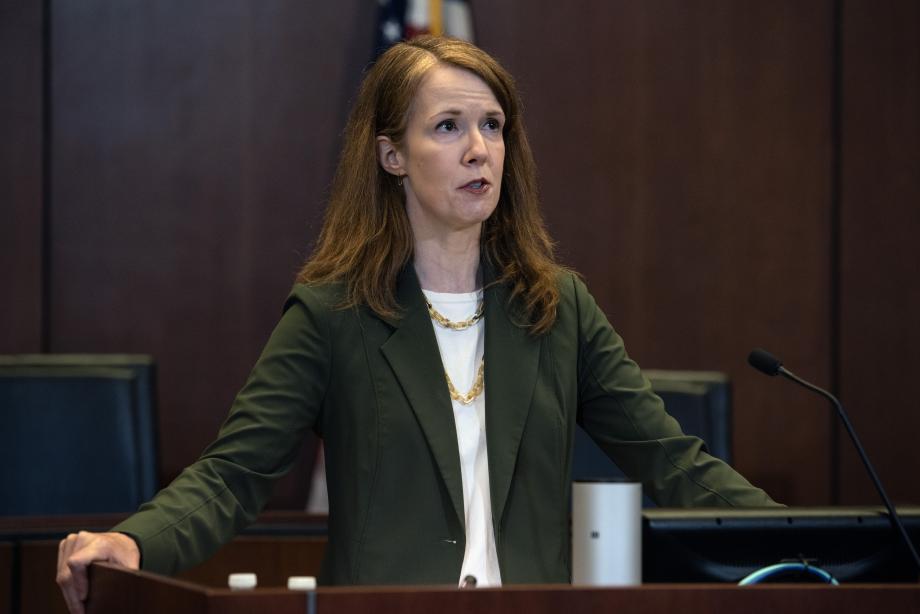Alison LaCroix Sheds Light on the “Interbellum Constitution” at 2024 Fulton Lecture

The decades between 1815 and 1861 did not see any changes to the text of the US Constitution. Yet, Alison LaCroix, the Robert Newton Reid Professor of Law and a faculty member in the History Department, contends that this period, which she calls the era of the Interbellum Constitution, was a time of profound transformation. In her new book, The Interbellum Constitution: Union, Commerce, and Slavery in the Age of Federalisms, LaCroix explores this neglected period, asserting that it was far from uneventful.
LaCroix, a legal historian who has served on the Presidential Commission on the Supreme Court, discussed her insights on May 7 at the Law School’s Fulton Lecture.
At the outset of the event, which was recorded by C-SPAN, LaCroix assured audiences that the plural “s” in “Federalisms” in the title of her book is not a typo. One of the key arguments that she makes is that many distinct “federalisms” existed during the Interbellum Period.
The political disagreements of the period involved multiple layers of government; they were not just between states and the central power. These “federalisms” concerned disputes among local county sheriffs, state legislators, private citizens, foreign relations, including with Native nations, the president’s cabinet, Congress, governors, and more. Intense political debates around how to divide powers swept the country and happened in various arenas, from newspapers to private letters to courtrooms.
“Early 19th century Americans were consumed by arguments about concurrent power, because how that power was to be demarcated just wasn’t clear from the constitution,” said LaCroix. “After 1815, most of the pressing legal and political debates concerned the domains in which concurrent power was debated, which were mainly commerce, migration, and slavery.”
According to LaCroix, the elaborate constitutional discourse of that period laid out much of the federalism landscape that we know today. Laws may have not changed during those years, but the meaning of the constitution itself was changing.
LaCroix highlighted two episodes from her book to illustrate the creative constitutional thinking of the Interbellum Period, focusing on the port city of Charleston, South Carolina, in the 1820s and 1830s.
The first involved Justice William Johnson, Jr., a nationalist and federal power advocate whose parents were Revolutionaries. Johnson presided over a case involving Henry Elkison, a free Black British sailor challenging a South Carolina law that mandated the jailing of free Black seamen. It wasn’t the first time a Black sailor challenged this law, but what made Elkison’s case unique was that the British government was funding and supporting it.
There were other levels of government involved in the battle as well, demonstrating that this was not a simple state versus federal dichotomy. Those other players included the local sheriff, the US Secretary of State, the US Attorney General, British ministers in London, the British consul in Charleston, and a private group called the South Carolina Association, who, interestingly, were the ones prosecuting the case.
Johnson ruled that the law violated federal authority over interstate and international trade, igniting a backlash and cries of nullification in Charleston.
The second episode centered on Maria Henrietta Pinckney, a staunch nullifier and daughter of famed patriot Charles Cotesworth Pinckney. Pinckney, who inherited the Pinckney Mansion and dubbed it “nullification castle,” published a radical pamphlet in 1830. Her writing argued that the American union was a compact of the states rather than a government formed by the people and criticized the Supreme Court's nationalistic power.
Interestingly, Johnson had studied law with Pinckney’s father and was a frequent visitor to the Pinckney Mansion. Despite their shared connections, however, Johnson and Pinckney drew vastly different conclusions from their constitutional heritage. “The lessons they drew from the legacy that informed both their lives could not have been more different,” said LaCroix.
LaCroix believes a key aspect of the Interbellum Period today is its ability to give context to moments of intense political and legal debate.
“Many commentators cite the Civil War as an analogy and a cautionary tale for the current moment, but the most accurate benchmark is not the war itself; it’s the five decades of simmering constitutional conflict that preceded the war’s outbreak,” she said. “The similarities between those years and today provide context, insights, and yes, perhaps a warning.”